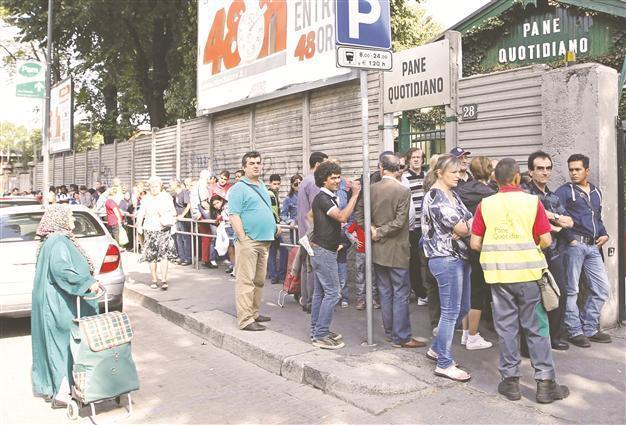Italian finances feel the heat as borrowing costs spike at auction
MILAN - Reuters

People wait in line for bread outside the charity organization ‘Pane Quotidiano’ (Everyday Bread), in Milan. Italy is looking at asset sales and spending cuts to shore up finances. AP photo
Italy’s three-year borrowing costs spiked to 5.3 percent at an
auction yesterday, underlining the mounting pressures on the eurozone’s third-largest
economy after a Spanish aid deal failed to convince investors that the bloc’s crisis can be contained.
With its economic reforms stalling and market speculation rising that it too may eventually need a bailout, Italy paid the most since December for three-year debt which it had sold at 3.9 percent only a month ago.
But in highly volatile markets just one day after a three-notch downgrade of Spain’s sovereign rating, Rome raised its top planned amount of 4.5 billion euros from three bonds and sold the debt at yields below market levels.
“These auctions will be judged a success in the short term, but the trend in yields and spreads is something which requires something from the policymaker level to reverse,” said Peter Chatwell, a rate strategist at Credit Agricole in London.
A smaller-than-average size helped the auction. Italy also sold 1.5 billion euros of two bonds maturing in Feb. 2019 and March 2020 which are no longer issued on a regular basis.
Yesterday, Italy’s benchmark 10-year yields rose to 6.3 percent, the highest since January, while Spain’s hit the 7 percent level at which other euro zone states were forced to seek support for their national finances.
Spanish bailout a game-changer
“The Spanish ‘bail-out’ was a game-changer. It’s putting Italy under extreme pressure because of the lack of differentiation in the markets,” said Nicholas Spiro, Managing Director at Spiro Sovereign Strategy. “There’s a sense among investors that Italy is the next domino to fall in the absence of bold and decisive eurozone-wide measures to stem the panic.”
A lack of details on a deal to aid Spain’s banks, worth up to 100 billion euros and agreed last weekend, has left investors fretting that Madrid and possibly even Rome may require further help from their euro zone peers and international lenders. Markets are also on edge ahead of Sunday’s general election in Greece, which threatens the integrity of the single currency.
A day earlier, Italy paid 3.97 percent on one-year paper, the highest yield in six months, amid rising concerns about its 1.9 trillion euro debt pile, the world’s fourth-largest.
The rise in Italian borrowing costs has undone the relief brought early in the year by the European Central Bank’s liquidity largesse. It threatens to undermine harsh deficit cuts by the Rome government, whose reform push has run out of steam.
Italy is looking at asset sales and spending cuts as it tries to further shore up its public finances.
Prime Minister Mario Monti asked for a quick approval of measures currently before parliament during an emergency meeting on Tuesday with party leaders of the majority which supports his unelected government. “This would help remove the view (that the reforms) are half-baked,” Monti said on June 13. But he also turned to European partners, urging credible pro-growth measures be decided at a summit at the end of this month, and said this would help shield Italy from contagion.
The head of debt management at Italy’s Treasury said last week that foreign investors were steering clear of Italian bonds ahead of the crucial end-June meeting and that domestic investors were making up for their fading appetite.
“With overseas investors shifting out of BTPs (Italian bonds), domestic investors are stepping up to the plate - but for how long?” said Nick Stamenkovic, a strategist at Ria Capital Markets. Italy’s Treasury has completed slightly more than half its annual bond issuance plan, estimated at around 215 billion euros.
Spain borrowing costs at historic high
MADRID - The Associated Press
Spain’s borrowing costs hit a high not seen since the country joined the euro in 1999 after a credit ratings agency downgraded the country’s ability to pay down its debt.
The interest rate -or yield- on the country’s benchmark 10 years bonds rose to a record 6.89 percent in early trading yesterday, close to the level which many analysts believe is unsustainable in the long term and at which countries such as Greece, Ireland and Portugal have sought an international bailout. The ratings agency Moody’s downgraded Spain’s sovereign debt three notches from A3 to Baa3 June 12 evening just one notch above “junk status.” Moody’s said the cut was due to the offer from eurozone leaders of up to 100 billion euros to Spain to prop up its banking sector, which the ratings agency believes will add considerably to the government’s debt burden. This score will mean that even fewer investors will buy Spanish debt as organizations are mandated not to invest in assets with such a low score.
